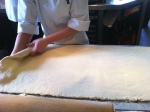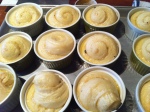Tags
For the past two years we’ve had a couple of different talented pastry chefs at the restaurant and I haven’t been working full time baking in the kitchen. But I still fill in for vacations or go in early to make jam or can cherries in red wine. One of my favorite tasks is to make the croissant dough near the end of the week for the weekend’s brunch pastries.
On those Thursdays I arrive in my sleepy kitchen before 6 o’clock, key in the code to the beeping alarm which assures me I’m alone, and turn on the lights. The first hour of my meditation requires a patient waiting. I assemble milk and yeast, honey and sea salt on the utilitarian stainless steel counter across from the stove. The copper pots, polished with coarse salt and lemon juice, are lined up in ascending size on the shelf above the black iron burners and hanging from the rack above my head, nearly out of reach. I choose one and think of pastry cooks in France using these same types of beautiful vessels a hundred years ago as I fill it with the rich whole milk and light the burner below. Using the back of my little finger I test the temperature, and then measure it into the waiting bowl. At some point during my pastry training in culinary school I knew the number of degrees the yeast likes best. That number has disintegrated into unintelligible digits in my brain but my body knows what’s right. I weigh out 1 7/8 ounces of the dormant fungus and sprinkle it evenly onto the quart of milk. Then I wait.
On dry mornings I often leave the yeast to awaken unwatched and run the three miles to the lake and back. But on rainy days I move more slowly and make a ritual out of my first coffee of the day. I take my time to steam some milk and pull perfect shots of espresso, after adjusting the grind just right. Taking the straight-sided, white porcelain cup in both hands and raising it to my lips feels like lighting a candle to punctuate a prayer.
The yeast sips at the warm milk as I on my cappuccino, waking slowly and not yet ready for breakfast. Neither am I. As it sucks in a child’s first meal it swells and grows heavy until it sinks to the bottom of the bowl, gluttonous and craving real food. I feed the yeast its one-quarter cup of honey, stir in two and a half tablespoons of sea salt as well to season the meal, and once again wait. This time I scramble some onion confit with a couple of eggs from Alice’s chickens who run free in her fields up north and sit down to enjoy my own breakfast.
As the yeast consumes the bee’s treasure it begins to sigh and breathe. Bubbles form and grow, showing that this mélange is a living thing. When it has nearly doubled in size I know it’s ready for the three pounds of flour which I stir in by hand until it forms a lumpy mass. That mass is the awkward adolescent I hope to raise to be a refined adult. I turn it out onto my altar of granite, dust it with flour and knead it three or four times just until it’s smooth, with the texture of a girls cheek, warm from the blush of thoughts new to her. After these preparations the dough and I are ready to begin our shared meditation.
With a weighty pin of northeastern hard maple, I roll the dough into a 16 inch square. It gives easily under the pin requiring no effort on my part. In the center I lay a two and a half pound slab of sweet butter I’d tenderized with three-quarters of a cup of flour and two teaspoons of lemon juice, and shaped the day before. While the yeast was feasting, I removed it from the refrigerator and allowed it to temper and soften to just the right point. The dough likes an early fall, temperate climate. It will tell me immediately if it is uncomfortable. After laying this slab of soft yellow on the duvet of milk and flour, I fold up the four corners over it like laundry fresh from the dryer. This bundle begins with its first three layers of dough, butter, dough- what will become 324 before I’m done.
I tenderly roll my pin across the top of the bundle, feeling the texture of the butter through the pillowy dough. This center is slightly firmer but softens with each pass of the pin as I coax it to 16 inches in width. I roll in the other direction until it’s nearly the length of the granite, pausing from time to time to dust it with flour and make sure it doesn’t cling to the slab of stone. I use a dry brush of natural bristle to brush away any loose flour. Then I slide my right arm under the right edge of the dough and cradle the 16 inches of its width, feeling it along the inside of my forearm and across the palm of my hand. I lay my left arm and hand on top of this same edge, palms together as if in prayer, and fold over one third of its length upon itself. I repeat a mirror image of this prayer, folding the left third onto the doubled middle. The three layers are now nine.
The butter has softened and warmed with each pass of the pin and the dough cannot be rushed, so I put it to rest in the refrigerator and distract myself with another task. If I disturb its rest too soon, it will respond by weeping butter from between layers of toughened dough when I roll it out. If I leave it too long the yeast will have time to sluggishly feed some more, making an uneven rise, and the butter will chill hard and crack when I try to massage it with the maple pin. Ninety minutes seems to be its preferred nap time. But each time is different. Like with a friend one has known for years, each encounter is unique. The moods of those close to us vary depending upon the state of their inner and outer worlds, and so it is too with this living amalgam of mother’s milk and earthen grain. I listen to it, hearing its needs with my touch and answer them through variations of speed, temperature and pressure.
After this first restful intermission I turn it out onto the flour-dusted slab of cool stone. This time its width becomes its length and its length its width, after I rotate the bundle one-quarter turn. I roll it to the previous dimensions and once again fold the ends of its length upon itself in thirds. The nine layers have grown to 27. After a second cool respite of an hour, we meet again on the plane of stone, I in my normal place and it turned again 90 degrees. I roll it to the consistent width but this time I push its length to beyond what my table can hold, and one end drapes over its edge. I fold one quarter of its length from each end upon itself and then fold them together as if closing a weighty volume by Escoffier. The 27 layers have now multiplied to 108.
With each rest and visit to the slab the dough grows stronger and less delicate. Its texture evolves and changes from that of a newborn to a child, then from a young adult to finish as that of a mature woman in her prime. Each time we join together in meditation, the dough and I, I revisit a home I never knew and a childhood I never had. As the texture evolves and changes I feel it grow in maturity and strength but also in sensitivity and vulnerability. This mirrors my own evolution through the first four stages of my life.
I bring the dough one last time to the stony altar and complete a final chorus of silent chant through movement. I am grateful for the opportunity to do this work I love. I am grateful to do so in the warmth and comfort of this welcoming kitchen. I am happy to know that once dusted with vanilla sugar, shaped, proofed and baked, guests will receive pleasure from my hands’ creation. And I am humbled to know that these guests trust me with such intimacy, the intimacy of taking into one’s body the art and labor of another’s hands. I feel all of this as I fold these 108 layers a final time into thirds, and with this gesture complete my meditation of 324.























Reblogged this on Writes With Pencils and commented:
Here’s an essay I wrote for my restaurant’s blog.
LikeLike
I think even I could make those now.
LikeLiked by 1 person
It’s all about the feel.
LikeLike
This ‘felt’ meditative. Comforting.
LikeLike
Thank you. That’s exactly what I was trying to convey.
LikeLiked by 1 person
Beautiful meditation! Thanks for sharing! And for all of the delicious calories over the years. xo
LikeLike
Thank you, and you’re welcome!
LikeLike
Lovely.
LikeLike
Thank you!
LikeLiked by 1 person
This is so beautifully written. Reading this post totally calmed my sometimes restless inner being. 🙂
LikeLiked by 1 person
Thank you, I’m so glad. I was hoping that my words could have the same effect on those who read them as the work described had on me.
LikeLike
Thanks so much for visiting my blog. I am glad to have such a reflective and interesting new friend. A beautiful dance, your baking, and an exercise in joy.
LikeLike
Thank you. I’m not baking too much these days, I miss it sometimes but still keep my hand in. I hadn’t realized that my little gravatar icon still linked to the Harvest Vine blog until I saw these comments from you and tested the link. The reason I’m not baking much is because I’m writing quite a lot. My writing blog is writeswithpencils.wordpress.com if you have time to take a look. I look forward to reading more of your work.
LikeLike
I most definitely will. My bread may turn out a little dense when I try to bake, but I spend far more time writing myself. See you there…
LikeLike